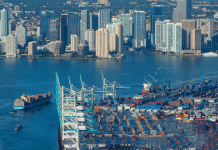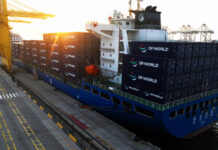Current transit sector trends promise a good year, Ansis Zeltiņš, Freeport of Riga CEO who has just completed his first full year as the head of the Port, said in an interview with Diena newspaper.
Zeltiņš named the Krievu Island development project takeover and successful implementation as one of the greatest challenges of his first year. Despite a history of various scandals surrounding the Krievu Island project and its ups and downs, it should be completed by a certain deadline. Now almost everyone agrees that the Port needs those terminals both now and in the context of future development. Undoubtedly, in such large scale projects a variety of numerous processes and work should happen simultaneously, including the actual construction work performed by both the Port and the owners of the new terminals. Zeltiņš is optimistic that until the end of the year, including early winter, the weather will be good enough to complete all the work on time. The second biggest challenge, according to the Freeport of Riga CEO, is the Port of Riga strategy for the next ten years, which should be completed and approved by the end of the year. This way, at the beginning of the next year, we will have a perfectly clear view of our development programme for the next ten years and the direction the Port of Riga will grow and operate.
Speaking of the future of the Port of Riga, Zeltiņš tells Diena that no radical changes are to be expected. Looking into the future, we have to take into account historical details of the port development, such as that the Port of Riga has always handled a large share of Russian cargo. Undoubtedly, in these circumstances the existing risk is that with cargo coming from Russia (mainly coal), no Russian party nor any private carrier or stevedore can give or get any guarantees that coal transit via the Port of Riga will continue and the volumes remain unchanged. At the same time, it doesn’t mean that the Port of Riga should turn away from those cargoes. We work and we will continue working with them, as they remain a very important element of the overall Port of Riga cargo operations. At the same time we have to be able to bring in niche cargoes, which historically have not been handled in the Port of Riga.
That, of course, requires more effort from private stevedores, says Zeltiņš, as clearly large cargo volumes are easier to handle because they bring easier and bigger profits, while niche cargoes require more work and do not offer that big a margin. At the same time, the latter have a much more stable effect, as potential changes in the cargo market have a smaller overall impact on cargo volumes. As for the main types, i.e. containers and general cargo, those will undoubtedly remain the centre of attention for the Freeport of Riga Authority.
‘I always have this goal in my head—to reach on million containers a year—and we are definitely heading that way,’ said the Freeport of Riga CEO. Of course, before we can achieve that goal there are many preconditions to be satisfied, which to a great extent are not directly related to the Port itself, since the Port is only one of the stages of container transportation. In particular, this is about access infrastructure, e.g. railway ensuring both physical and functional railway capacity. As is known, Latvian Railways is actively working on both Far East and South East directions. It is also important to increase the future share of industrial cargo. In this case, manufactures do not have to be within the Port of Riga territory. The Port of Riga has already established the foundation for cooperation with Belarusian cellulose manufacturers. Their manufacturing facilities are situated in Belarus, but if we are able to create the necessary warehousing complex and ensure cellulose handling in the Port of Riga, it will have a bigger and more stable long-term impact than the containers. For example, if currently a container forwarder is using the Port of Riga, in a couple of years he may choose another route; moreover, to guarantee our handling volumes, in the near future we will definitely try to bring certain type of production companies to the Port itself, which has never happened before,’ added Zeltiņš.
Speaking about the expected 2018 results, Zeltiņš is optimistic: apart from liquid cargoes whose volumes have dropped dramatically and are unlikely to recover, all other cargo segments show growth, including coal, and if nothing changes significantly this year coal handling may see substantial growth. The same trend is observed in the grain segment, with almost 800 thousand tons handled in the first six months. The beginning of the year saw a slight drop y/y, but the results of the first six months already show apparent growth compared with the same period in 2017. We are cautiously pessimistic in our plans, but if current trends continue, this year will be a very good one for the Port of Riga, Zeltiņš tells Diena.





